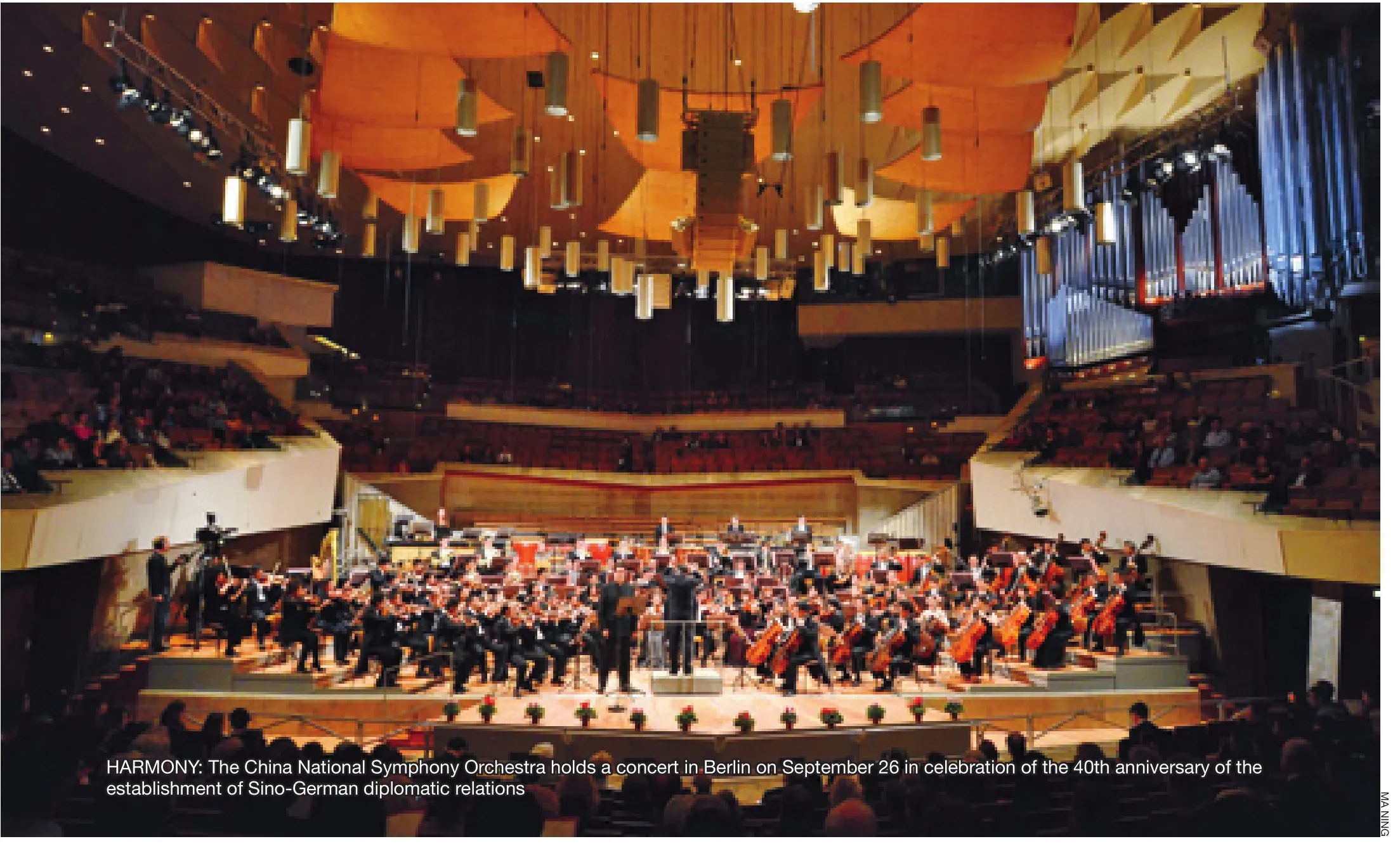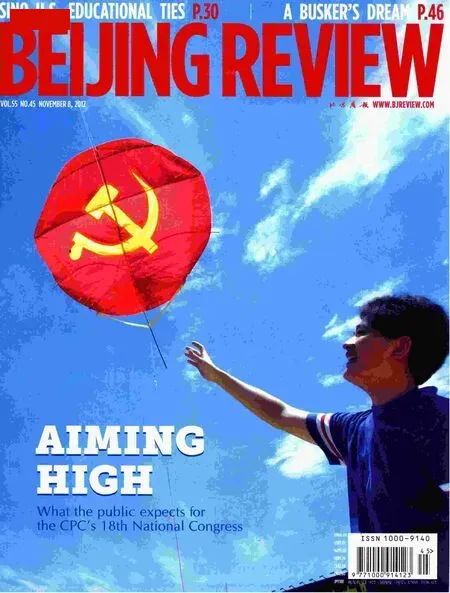From the Confines To the Core
By Meng Hong
From the Confines To the Core
By Meng Hong
Sino-German relations make big strides over the last four decades

The author is deputy director of the Center of Germ an Studies at Renm in University of China
W ith the signing of a joint communiqué in Beijing on October 11, 1972, the People’s Republic of China (PRC) and what was then West Germany officially established diplomatic relations, opening the prelude to the full normalization of relations between the PRC and the West.
W ithin the last 40 years since the establishment of diplomatic relations, bilateral relations between China and Germany have seen ups and downs, but relations between the two are stronger than ever.
Step-by-stepties
The rapid development of Sino-German relations is closely linked to their historical exchanges and the unyielding national spirit of both nations. As early as the late M ing Dynasty (1368-1644), cultural and econom ic exchanges had already started. In 1861, the government of the Qing Dynasty (1644-1911) established an official relationship w ith the German Government.Soon after, Germany, w ith its thriving national power, was regarded as a highly prized model by pioneers of Chinese modernization. However, as Germany became the focus of two world wars in the fi rst half of the 20th century, Sino-German relations were severely strained and even suspended.
World War II caused Germany to split up. The PRC established diplomatic relations w ith East Germany shortly after its founding in 1949. Its relationship w ith West Germany,which followed a pro-Western foreign policy,did not get a favorable turn until the early 1970s when W illy Brandt, Chancellor of West Germany, carried out his New Eastern Policy and China restored its legitimate seat in the UN.
In 1975, Helmut Schm idt became the first chancellor of W est Germany to visit Beijing. A fter China adopted its reform and opening-up policy in 1978, high-level visits between the two countries were frequent and their cooperation greatly deepened. Overall relations between China and Germany saw a big leap during the 1980s and the 1990s despite several political setbacks. In 1993,German Chancellor Helmut Kohl put forward Germany’s new Asia policy, centering for the first time on China. The two built the Sino-German partnership of global responsibility in 2004, and the partnership was elevated to a strategic partnership in 2010.
In recent years, both countries have attached more importance to cooperation in the international arena. On platforms such as the UN General Assembly, Group of 20 summ its and the Asia-Europe Meeting and through high-level official hotlines, effective cooperation has been carried out in resolving global issues such as the financial crisis,climate change, poverty and terrorism. Since 2006, the two countries’ heads of government have made bilateral exchange visits six times.Furthermore, cooperation between the two countries’ parliaments was institutionalized in 2005. In June 2011, Sino-German intergovernmental consultations were created, laying a much more solid foundation for the two countries to strengthen their comprehensive strategic partnership.
Economic cooperation
Sino-German economic cooperation has always been an important pillar of bilateral relations.Trade cooperation was already underway even before the establishment of diplomatic ties. After 1972, Sino-German econom ic cooperation greatly advanced. Currently, China is Germany’s largest trading partner outside the EU and its largest source of imports worldwide. Meanwhile,Germany is one of the largest investors and technology suppliers to China. Their trade volume increased from $274 million in 1972 to $169.15 billion in 2011.
On the whole, rapidly grow ing bilateral economic relations benefi t from both China’s industrialization in the last 30 years and the financial assistance and technological support provided by Germany to China since 1979 when West Germany acknow ledged China’s identity as a developing country. By April 2012, Germany had exported 16,796 new technologies to China, worth $55.73 billion.In the meantime, Germany had invested in 7,437 projects on the Chinese mainland w ith a total sum of $18.67 billion. Moreover, after China’s adm ission to the WTO in 2001, the two governments further improved a bilateral trade for deeper economic cooperation.

Since the severe debt crisis hit the EU in 2008, economic cooperation between the two saw great changes. A fter Germany ended traditional development assistance to China in 2009, the two sides strengthened cooperation in climate change mitigation, environmental protection and energy conservation. Centering on the econom ic policy goals of China’s 12th Five-Year Plan (2011-15), bilateral cooperation has focused more on strategic emerging industries such as new energy, new material,medical technology, aerospace technology and electric vehicles since 2010. Cooperation in financial and insurance industries was also strengthened. Meanwhile, China’s investment in Germany increased sw iftly. In 2011,China surpassed the United States to become one of the largest foreign direct investors in Germany.
Cu ltu re, science know how
The great importance attached by the governments of the two countries on cultural exchanges and education and technology cooperation also contributed a lot to the rapid grow th of bilateral relations.
A fter the two sides signed protocols on science and technology and cultural exchanges in 1978 and 1979, a higher education cooperation agreement was signed in 2002. In 2006, the two sides also set up talks for cooperation in higher education.
In 1988, the Goethe Institute set up its first branch in Beijing. M any German corporate foundations as well as cultural organizations, including the German Academic Exchange Service, thereafter set up o ffices in China. In 2008, a Chinese Culture Center settled in Berlin. In addition, about 12 Confucius Institutes have been set up across Germany. In the fields of science and technology, together w ith the National Natural Science Foundation of China, the German Research Foundation established a Sino-German science promotion center in 2000 in Beijing. Other famous German research institutes have also conducted active cooperation w ith their Chinese counterparts. In 2011, the Leibnitz Association created a Sino-German maritime science center in Qingdao,Shandong Province, joining hands w ith the Ocean University of China.
Cultural exchanges between the two have ranged from language, music, art and opera to ideological dialogue with a profound influence on modernization and urbanization, as evidenced by the three-year-long “Germany and China—M ove Ahead Together” campaign from 2007 to 2010 in China and the Chinese Culture Year held this year in Germany. The participants and scope of cultural exchanges have expanded from college students to middle school students, from big metropolises to smaller cities, and from intergovernmental to people-to-people. At present, there are 70 pairs of sister cities and 750 interschool partnerships between the two countries. The number of overseas students in each other’s countries has also seen dramatic increase.
Mu tua l bene fits
China, as a permanent member of the UN Security Council and the world’s second largest economy, has played an important role in global political and economic issues. At the same time,Germany is the world’s fourth largest economy and a bellwether of European integration. Its influence in regional and global issues is also notable. In the last decades, the fruitful Sino-German cooperation has not only promoted the rapid social and economic development of China and its connection with the international community, but also gave a boost to German economic grow th.
Although the two sides have maintained close economic and cultural ties, their military exchanges are limited by the EU’s arms embargo on China. There are also major differences in political systems cultures and geopolitical interests between the two sides. Therefore, a friendly Sino-German relationship in the future still requires unremitting efforts from both official and nongovernmental levels.

